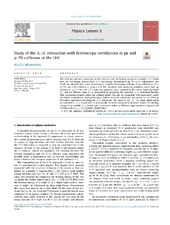Study of the Λ–Λ interaction with femtoscopy correlations in pp and p–Pb collisions at the LHC
Acharya, Shreyasi; Adamová, Dagmar; Adhya, Souvik Priyam; Adler, A.; Adolfsson, Jonatan; Aggarwal, Madan M.; Aglieri Rinella, Gianluca; Agnello, Michelangelo; Agrawal, Neelima; Ahammed, Zubayer; Alme, Johan; Altenkaemper, Lucas; Ersdal, Magnus Rentsch; Fionda, Fiorella Maria Celeste; Grøttvik, Ola Slettevoll; Lofnes, Ingrid Mckibben; Nystrand, Joakim; Rehman, Attiq ur; Røhrich, Dieter; Tambave, Ganesh Jagannath; Ullaland, Kjetil; Wagner, Boris; Yang, Shiming; Yuan, Shiming; Zhou, Zhuo; Arsene, Ionut Cristian; Bätzing, Paul Christoph; Dordic, Olja; Lardeux, Antoine Xavier; Lindal, Svein; Mahmood, Sohail Musa; Malik, Qasim Waheed; Richter, Matthias; Røed, Ketil; Skaali, Toralf Bernhard; Tveter, Trine Spedstad; Wikne, Jon Christopher; Zhao, Chengxin; Helstrup, Håvard; Hetland, Kristin Fanebust; Kileng, Bjarte; Nesbø, Simon Voigt; Storetvedt, Maksim Melnik; Langøy, Rune; Lien, Jørgen André; Ahmad, Shafiq F.; Ahn, Sang Un; Aiola, Salvatore; Akindinov, Alexander; Al-Turany, Mohammed; ALICE, Collaboration
Peer reviewed, Journal article
Published version

Åpne
Permanent lenke
https://hdl.handle.net/1956/22496Utgivelsesdato
2019-10-10Metadata
Vis full innførselSamlinger
Originalversjon
https://doi.org/10.1016/j.physletb.2019.134822Sammendrag
This work presents new constraints on the existence and the binding energy of a possible Λ–Λ bound state, the H-dibaryon, derived from Λ–Λ femtoscopic measurements by the ALICE collaboration. The results are obtained from a new measurement using the femtoscopy technique in pp collisions at √s = 13 TeV and p–Pb collisions at √sNN = 5.02 TeV, combined with previously published results from pp collisions at √s = 7 TeV. The Λ–Λ scattering parameter space, spanned by the inverse scattering length f_0^−1 and the effective range d_0, is constrained by comparing the measured Λ–Λ correlation function with calculations obtained within the Lednický model. The data are compatible with hypernuclei results and lattice computations, both predicting a shallow attractive interaction, and permit to test different theoretical approaches describing the Λ–Λ interaction. The region in the (f _0^−1 ,d_0) plane which would accommodate a Λ–Λ bound state is substantially restricted compared to previous studies. The binding energy of the possible Λ–Λ bound state is estimated within an effective-range expansion approach and is found to be B_ΛΛ = 3.2+1.6−2.4(stat)+1.8−1.0(syst) MeV.
